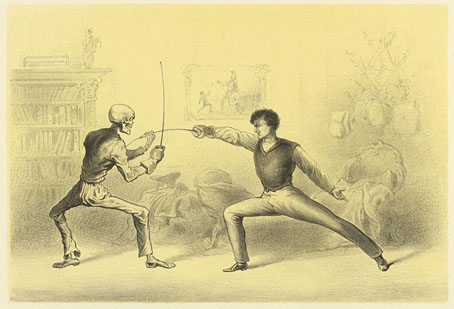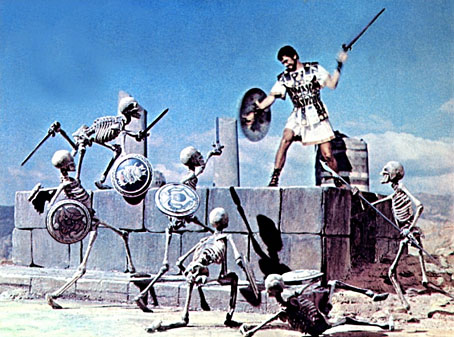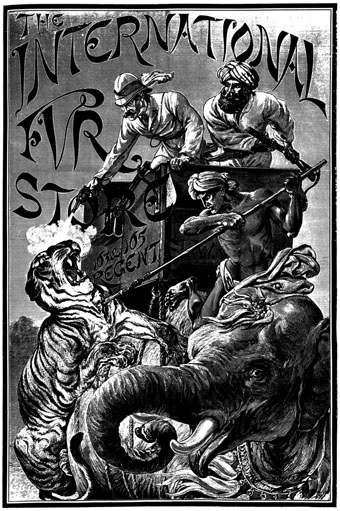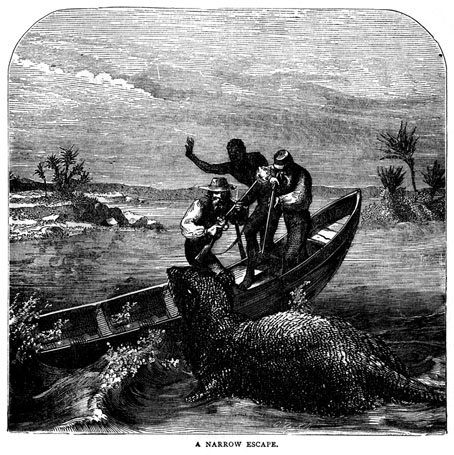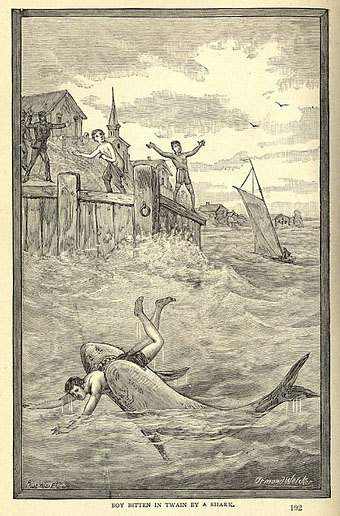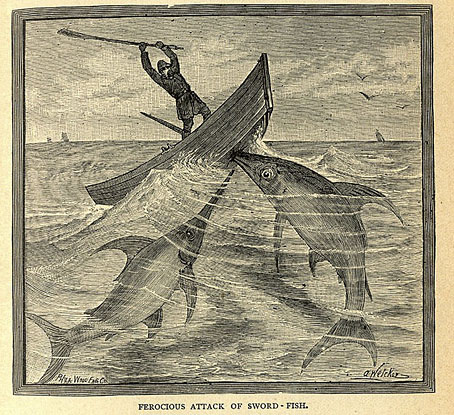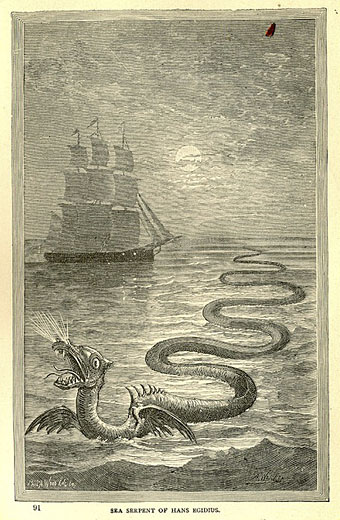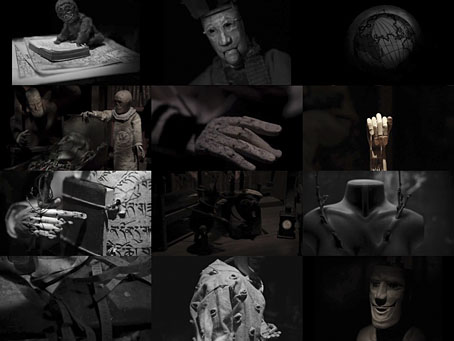Earlier this week Mr BibliOdyssey posted a link on Twitter to a blog entry of his from 2008, a collection of prints by Dutch artist Alexander Ver Huell (1822–1897). If I’d seen his post originally I didn’t recall it so this swordfight gives me an opportunity to draw attention to Ver Huell’s macabre and diabolical work. This unwinnable duel brings to mind the battle with the band of skeletons from Ray Harryhausen’s Jason and the Argonauts (1963), one of my favourite things in the whole world when I was 10. Given how many of the pictures in the Men with swords archive have a quasi-classical theme it’s perhaps appropriate to list Jason and co. among them.
“Die you brute!”
Since mention was made yesterday of the “Die you brute!” school of period illustration it seemed pertinent to post the picture that gave rise to the expression. This is another 19th-century ad from Victorian Advertisements (1968) by Leonard de Vries, the picture having appeared originally in The Illustrated Sporting and Dramatic News for November 1887. The Victorians may have been fond of their furs but they can’t be accused of downplaying the brutality behind the trade; in advertising terms this is like promoting a steak house with scenes from an abattoir. (And in that vein, see this Bovril ad from De Vries’ book.)
I produced my own variation on the theme in 2003 with this illustration for Michael Moorcock’s Samoan Giant Rat Bite Fever, his entry in the Thackery T. Lambshead Pocket Guide to Eccentric and Discredited Diseases . The Giant Rat is described as seven feet in length but I followed the usual form with these kinds of depictions and exaggerated the size.
Previously on { feuilleton }
• Gilliam’s shaver and Bovril by electrocution
Sea and Land: An Illustrated History
It’s all fun and games until someone gets bitten in twain by a shark. Illustrations from a Flickr selection of plates from Sea and Land: An Illustrated History (1887) by JW Buel, a compendium of stories about the natural world which tend towards the sensational. Many of these pictures are from what I call the “Die you brute!” school of illustration, in which exotic fauna is always on the rampage and needs to be violently subdued before someone is eaten alive (or bitten in twain). Buel’s book reprints pictures from other volumes including Gustave Doré’s Rime of the Ancient Mariner while one of the tentacled fiends below is an oft-reprinted item by Alphonse de Neuville & Edouard Riou from Twenty Thousand Leagues Under the Sea. The only copy of Sea and Land at the Internet Archive is poor quality, unfortunately; being partial to Victorian sensation I wouldn’t mind seeing the whole thing.
Carnival designs from New Orleans
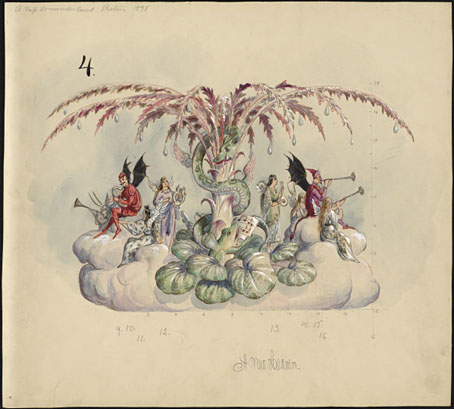
A New Heaven: float design from Krewe of Proteus 1898 parade. Theme: A trip to Wonderland.
A very random selection from a vast collection (5545 items) of designs for carnival floats and costumes at the Louisiana Digital Library. BibliOdyssey had a post about New Orleans carnival designs a couple of years ago, and the plates featured there are also present in the LDL collection.
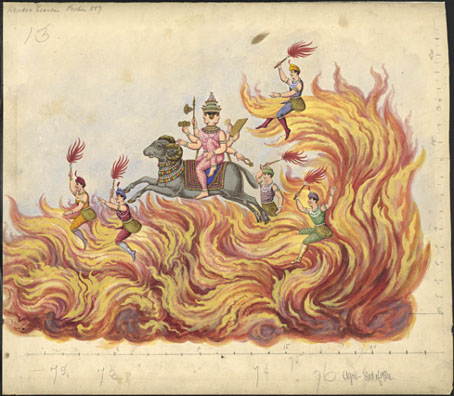
Agni – God of Fire: float design from Krewe of Proteus 1889 parade. Theme: The Hindoo Heavens.
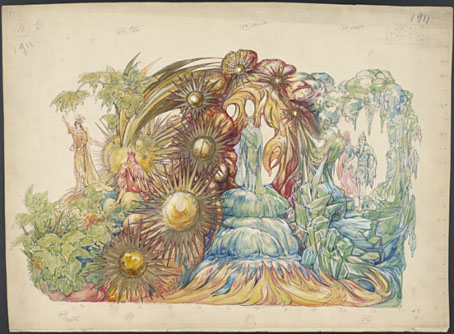
All that glitters is not gold: float design from Mistick Krewe of Comus 1911 parade. Theme: Familiar Quotations.
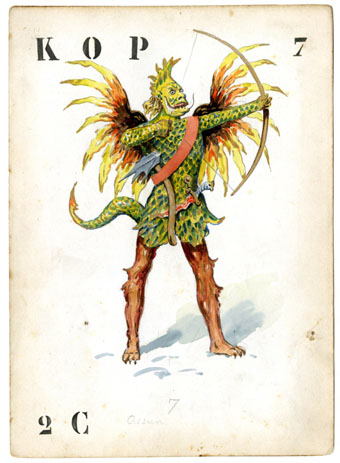
Assuri 01: costume design from Krewe of Proteus 1885 parade. Theme: Myths and Worships of the Chinese.
Three Fragments of a Lost Tale
I hadn’t come across sculptor John Frame’s animated work before so my thanks to John Burridge for the recommendation. Three Fragments of a Lost Tale is part of a larger project, The Tale of The Crippled Boy, which is described at Frame’s website. Being a collection of fragments, this film is necessarily mysterious although I seldom worry about that. One quality of animation I’ve always enjoyed is its ability to convey the disjunctions and strange atmospheres of dream states, something it often does more effectively than anything else.
Previously on { feuilleton }
• Brothers Quay scarcities
• Achilles by Barry JC Purves
• The Torchbearer by Václav Svankmajer

